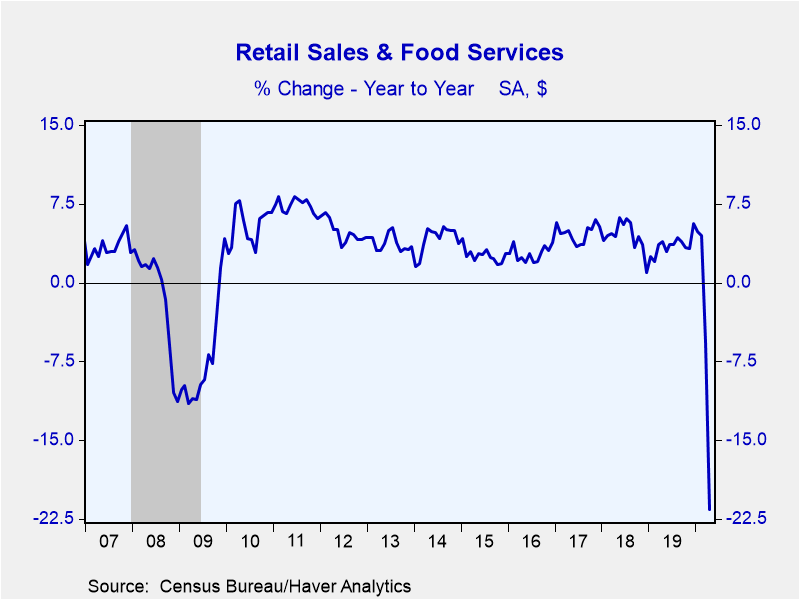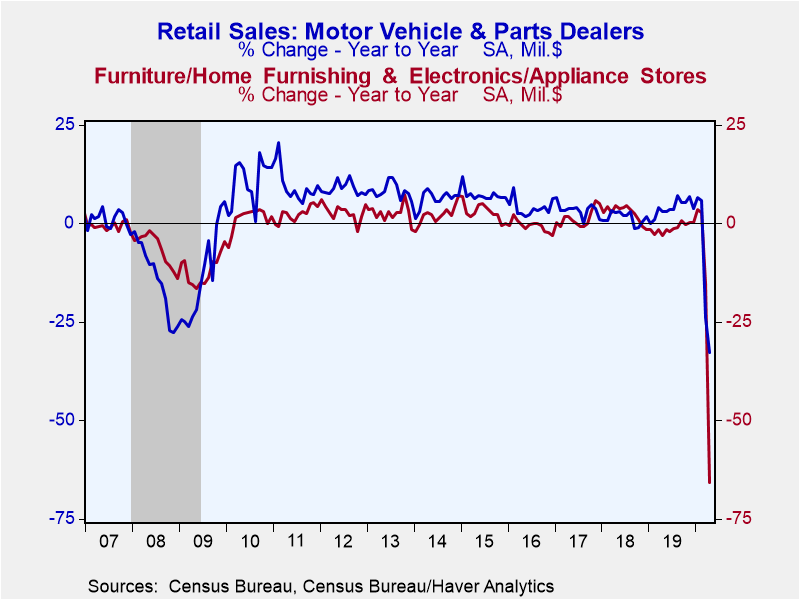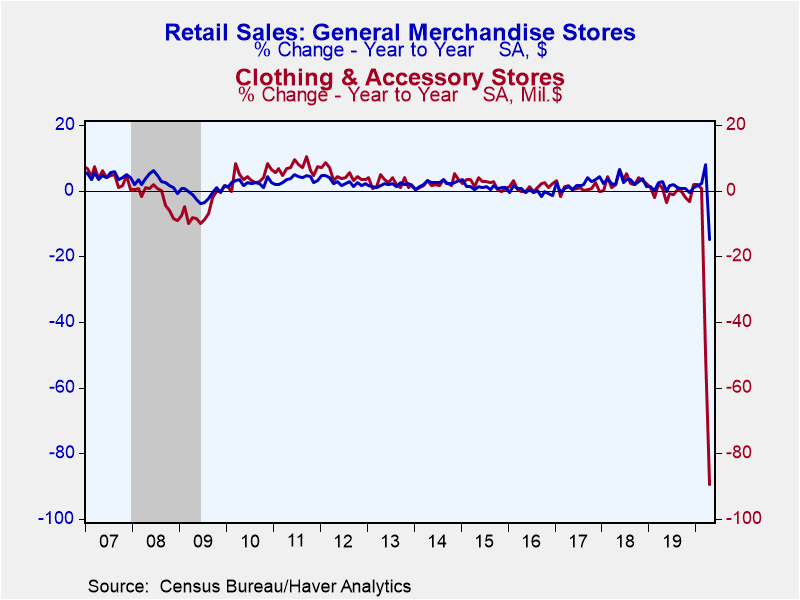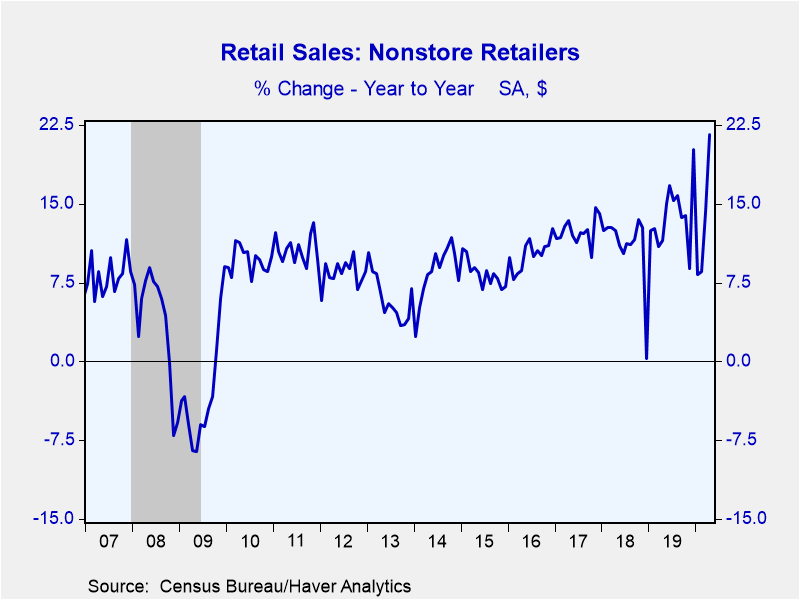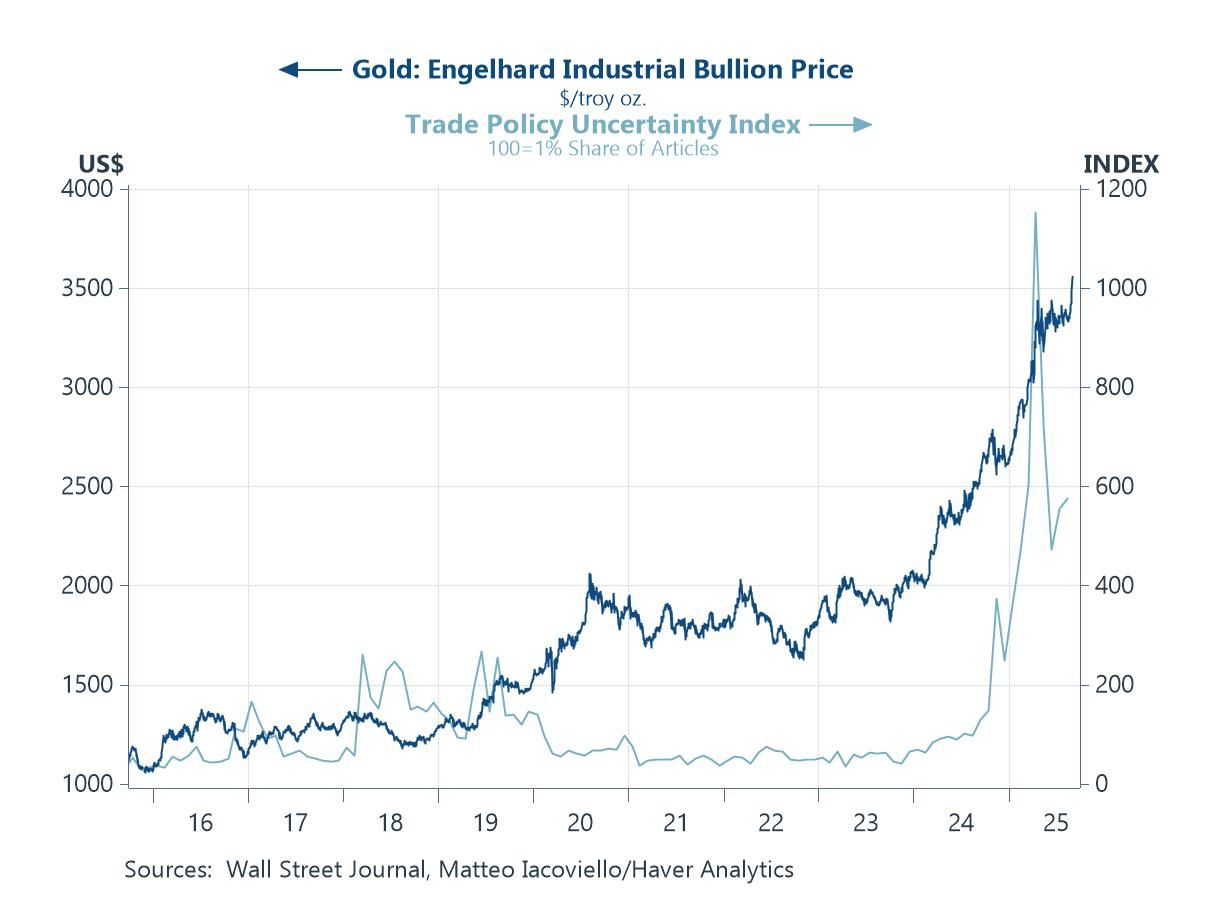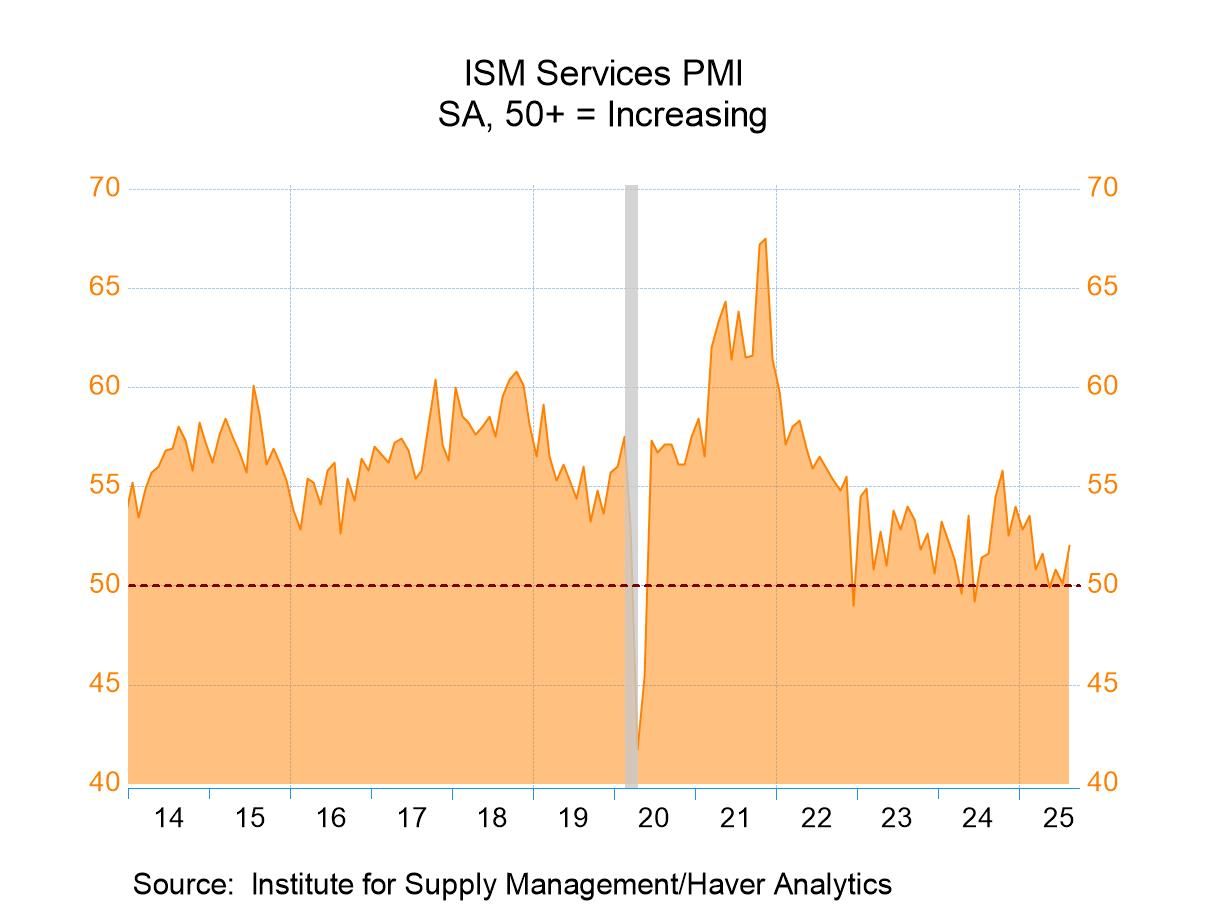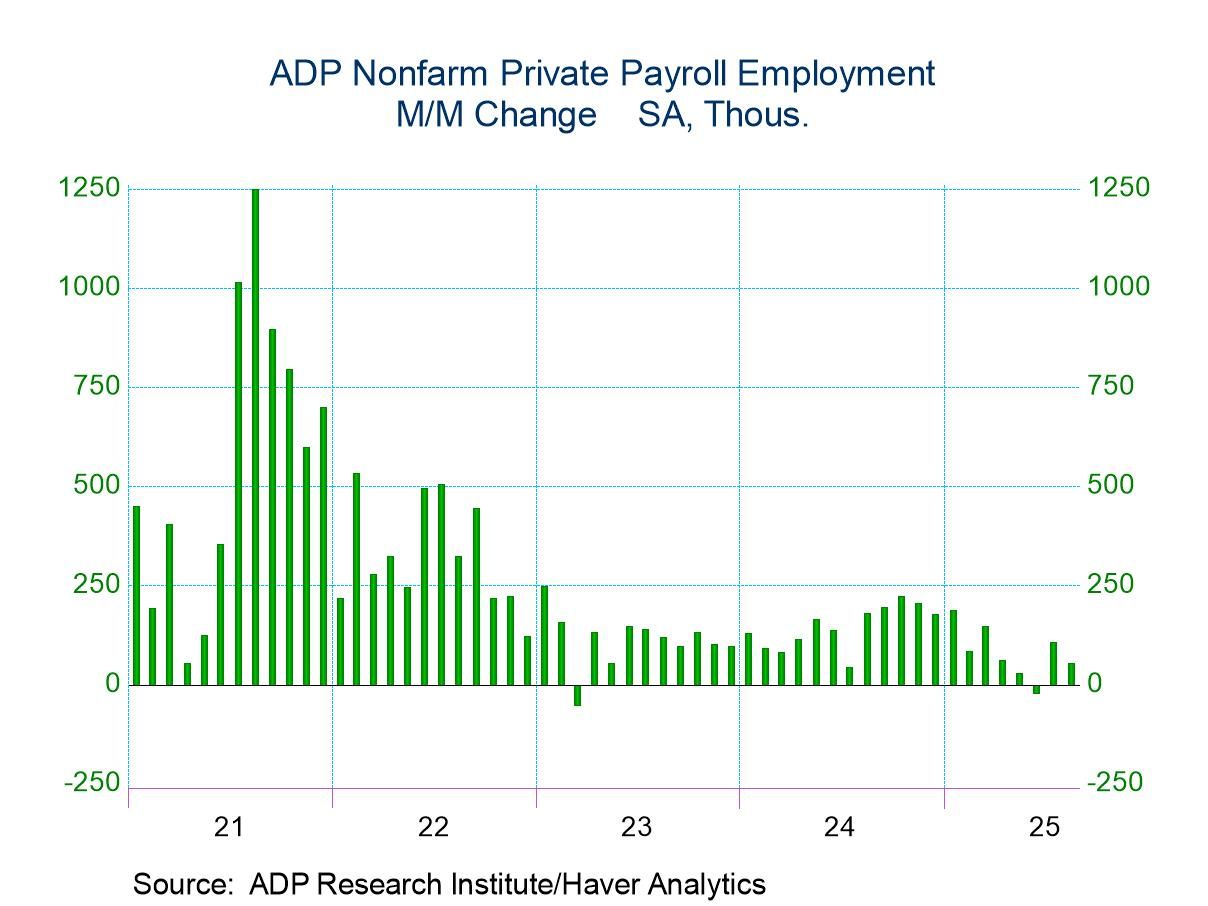 Global| May 15 2020
Global| May 15 2020U.S. Retail and Food Service Sales Post Record Decline
by:Tom Moeller
|in:Economy in Brief
Summary
• Consumers pull back as coronavirus takes hold. • Spending cutbacks are broad-based. Social distancing, store closings and travel restrictions took their toll on consumer spending last month. Total retail sales, including food [...]
• Consumers pull back as coronavirus takes hold.
• Spending cutbacks are broad-based.
Social distancing, store closings and travel restrictions took their toll on consumer spending last month. Total retail sales, including food service establishments, fell a record 16.4% (-21.6% y/y) during April after weakening 8.3% in March and easing 0.4% in February. An 11.5% decline had been expected in the Action Economics Forecast Survey. Retail sales excluding motor vehicles & parts were off 17.2% (-18.8% y/y) after falling 4.0%. An 8.3% decline had been anticipated.
Retail sales excluding food service establishments fell a record 15.1% last month (-17.8% y/y) after weakening 5.3% in March. Sales of motor vehicle & parts dealerships fell 12.4% (-32.9% y/y) as unit sales of motor vehicles weakened by one-quarter m/m and nearly one-half y/y. Gasoline & service station sales fell 28.8% (-42.8% y/y) as prices declined and driving was curtailed by stay-at-home restrictions.
Apparel & accessory store sales plummeted 78.8% (-89.3% y/y), down for the fourth straight month. Electronics & appliance store sales were off 60.6% (-64.8% y/y), the third straight monthly fall. Sales at furniture & home furnishings stores weakened 58.7% (-66.5% y/y) after falling 21.1% in March. Sporting goods, hobby, book & music store sales fell 38.0% and by nearly one-half y/y.
As consumers turned to ordering from home, sales of nonstore retailers rose 8.4% (21.6% y/y) after improving 4.9% in March. General merchandise stores, however, realized a 20.8% decline (-14.9% y/y). Building materials & garden store sales fell 3.5% (+0.4% y/y), the third straight monthly decline.
Food & beverage store sales declined 13.1% (+12.0% y/y) after rising 26.9% in March. Another nondiscretionary category, health & personal care product sales, weakened 15.2% (-10.4% y/y) after rising 5.0%.
Outside of the goods spending categories, restaurant and bar sales declined 29.5% (-48.7% y/y) with widespread closures of dining establishments.
The retail sales data can be found in Haver's USECON database. The Action Economics forecast is in the AS1REPNA database.
| Retail Spending (% chg) | Apr | Mar | Feb | Apr Y/Y | 2019 | 2018 | 2017 |
|---|---|---|---|---|---|---|---|
| Total Retail Sales & Food Services | -16.4 | -8.3 | -0.4 | -21.6 | 3.5 | 4.8 | 4.6 |
| Excluding Autos | -17.2 | -4.0 | -0.5 | -18.8 | 3.4 | 5.5 | 5.0 |
| Retail Sales | -15.1 | -5.3 | -0.5 | -17.8 | 3.4 | 4.6 | 4.5 |
| Retail Less Autos | -15.7 | 0.7 | -0.5 | -13.4 | 3.2 | 5.3 | 4.8 |
| Motor Vehicle & Parts | -12.4 | -25.7 | -0.4 | -32.9 | 4.0 | 2.3 | 3.4 |
| Food & Beverage Stores | -13.1 | 26.9 | -0.1 | 12.0 | 3.0 | 4.0 | 4.2 |
| Gasoline Service Stations | -28.8 | -16.5 | -2.9 | -42.8 | 0.3 | 12.6 | 8.9 |
| Food Service & Drinking Places | -29.5 | -29.7 | -0.3 | -48.7 | 4.4 | 6.3 | 5.9 |
Tom Moeller
AuthorMore in Author Profile »Prior to joining Haver Analytics in 2000, Mr. Moeller worked as the Economist at Chancellor Capital Management from 1985 to 1999. There, he developed comprehensive economic forecasts and interpreted economic data for equity and fixed income portfolio managers. Also at Chancellor, Mr. Moeller worked as an equity analyst and was responsible for researching and rating companies in the economically sensitive automobile and housing industries for investment in Chancellor’s equity portfolio. Prior to joining Chancellor, Mr. Moeller was an Economist at Citibank from 1979 to 1984. He also analyzed pricing behavior in the metals industry for the Council on Wage and Price Stability in Washington, D.C. In 1999, Mr. Moeller received the award for most accurate forecast from the Forecasters' Club of New York. From 1990 to 1992 he was President of the New York Association for Business Economists. Mr. Moeller earned an M.B.A. in Finance from Fordham University, where he graduated in 1987. He holds a Bachelor of Arts in Economics from George Washington University.


